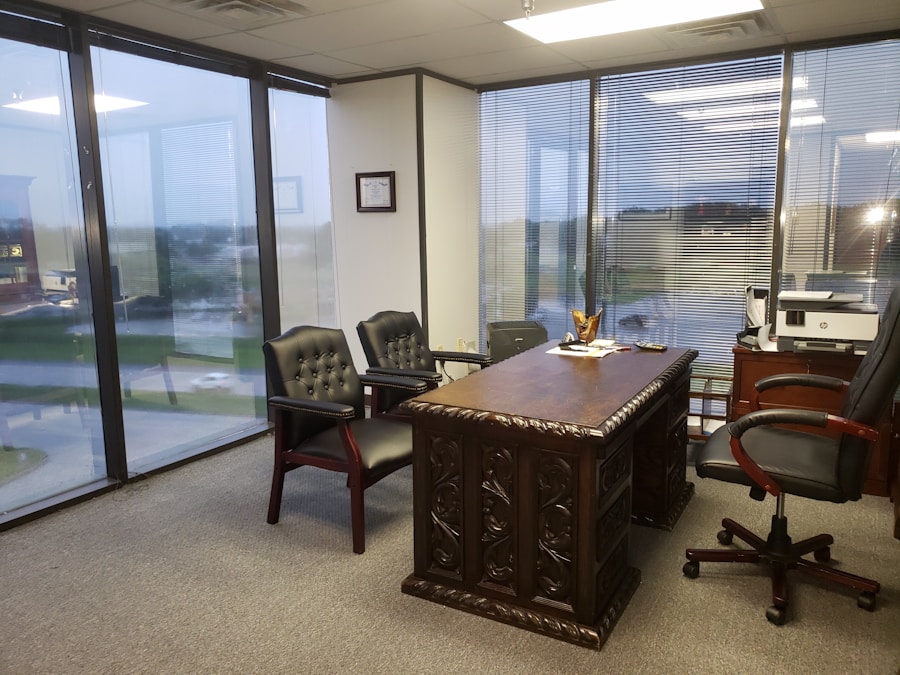The reception area of an office serves as the first point of contact for clients, visitors, and employees alike. It is a space that embodies the ethos and culture of the organization, making its design and atmosphere crucial to the overall impression one leaves with. A welcoming reception can significantly influence a visitor’s perception of the company, setting the tone for their entire experience.
Research has shown that first impressions are formed within seconds, and a well-designed reception area can foster a sense of trust and professionalism. This initial interaction can be pivotal in establishing long-term relationships with clients and partners. Moreover, a welcoming reception area can enhance employee morale and productivity.
When staff members feel proud of their workplace environment, it can lead to increased job satisfaction and a stronger sense of belonging. A thoughtfully designed reception not only reflects the company’s brand but also creates an inviting atmosphere that encourages collaboration and communication among employees. In this way, the reception area becomes more than just a waiting space; it transforms into a hub of activity that embodies the values and mission of the organization.
Key Takeaways
- A welcoming office reception is crucial for creating a positive first impression on visitors and clients.
- The design of the reception area should be inviting, professional, and reflective of the company’s brand.
- Reception staff should be trained to greet visitors warmly, handle inquiries efficiently, and maintain a professional demeanor.
- Comfortable seating in the reception area is essential for creating a pleasant waiting experience for visitors.
- Clear signage should be implemented to help visitors easily navigate the office space.
Designing the Reception Area
Designing an effective reception area requires careful consideration of various elements, including layout, color schemes, furniture, and decor. The layout should facilitate smooth traffic flow, allowing visitors to navigate easily without feeling cramped or confused. Open spaces can create a sense of freedom, while strategically placed furniture can guide visitors toward the reception desk.
Additionally, incorporating elements such as plants or artwork can enhance the aesthetic appeal and create a more inviting atmosphere. Color schemes play a vital role in setting the mood of the reception area. Warm colors like soft yellows or earthy tones can evoke feelings of comfort and friendliness, while cooler colors like blues and greens can promote calmness and professionalism.
The choice of furniture is equally important; comfortable seating options not only make visitors feel at ease but also reflect the company’s commitment to hospitality. Incorporating unique design elements that align with the company’s branding can further reinforce its identity, making the reception area a memorable experience for all who enter.
Training Reception Staff

The role of reception staff extends far beyond merely answering phones or greeting visitors; they are often the face of the organization and play a crucial role in shaping perceptions. Therefore, comprehensive training is essential to equip them with the skills necessary to handle various situations with professionalism and grace. Training should encompass not only customer service skills but also knowledge about the company’s products, services, and values.
This enables receptionists to provide accurate information and answer questions confidently. In addition to technical knowledge, training should also focus on interpersonal skills. Reception staff should be trained to read body language, manage stress, and communicate effectively with diverse groups of people.
Role-playing scenarios can be an effective training method, allowing staff to practice handling difficult situations or unexpected inquiries in a controlled environment. By investing in thorough training programs, organizations can ensure that their reception staff are not only welcoming but also capable of representing the company’s values and mission effectively.
Providing Comfortable Seating
Comfortable seating is a fundamental aspect of any reception area, as it directly impacts the visitor experience. When guests arrive at an office, they often have to wait for appointments or meetings, making it essential to provide seating that is both comfortable and aesthetically pleasing. The choice of seating should reflect the overall design theme of the reception area while also prioritizing ergonomics.
Options such as plush chairs or sofas can create a relaxed atmosphere, while sleek benches may convey a more modern aesthetic. In addition to comfort, seating arrangements should promote social interaction among visitors. Group seating areas can encourage conversation and networking opportunities, fostering a sense of community even before formal meetings begin.
Furthermore, providing a variety of seating options can cater to different preferences and needs, ensuring that all visitors feel welcome and accommodated. By prioritizing comfort in seating design, organizations can enhance the overall experience for their guests.
Implementing Clear Signage
Clear signage is an often-overlooked aspect of reception area design that plays a critical role in guiding visitors through the space. Effective signage should be strategically placed to direct guests to key areas such as restrooms, meeting rooms, or exits. This not only enhances the visitor experience by reducing confusion but also reflects positively on the organization’s attention to detail and professionalism.
The design of signage should be consistent with the overall branding of the company. Using colors, fonts, and logos that align with the corporate identity can reinforce brand recognition while ensuring that signage is easily readable from a distance. Additionally, incorporating multilingual signs can accommodate diverse visitors and create an inclusive environment.
By investing in clear and effective signage, organizations can streamline navigation within their reception areas and enhance overall visitor satisfaction.
Utilizing Technology for Efficiency

In today’s fast-paced business environment, technology plays an integral role in enhancing efficiency within office reception areas. Implementing digital check-in systems can streamline the visitor registration process, reducing wait times and improving overall efficiency. These systems allow guests to sign in electronically, providing them with instant notifications about their appointments while freeing up reception staff to focus on other tasks.
Moreover, utilizing technology such as visitor management software can enhance security by tracking who enters and exits the building. This not only ensures safety but also provides valuable data for organizations looking to improve their operations further. Additionally, incorporating interactive kiosks or tablets in the reception area can provide visitors with information about the company’s services or upcoming events at their fingertips.
By embracing technology in the reception area, organizations can create a more efficient and modern experience for both visitors and staff.
Offering Refreshments and Amenities
Providing refreshments and amenities in the reception area can significantly enhance the visitor experience by creating a hospitable environment. Simple offerings such as coffee, tea, water, or light snacks can make guests feel valued and appreciated while they wait for their appointments. This small gesture not only reflects well on the organization but also contributes to a more relaxed atmosphere.
In addition to beverages and snacks, other amenities such as magazines or Wi-Fi access can further improve visitor comfort during their wait time. Offering charging stations for electronic devices is another thoughtful touch that caters to today’s tech-savvy guests who may need to recharge their phones or laptops while waiting. By considering these additional amenities, organizations can elevate their reception areas into spaces that prioritize guest comfort and satisfaction.
Incorporating Personalized Touches
Personalization is key to creating a memorable visitor experience in any office reception area. Simple yet thoughtful touches can make guests feel special and appreciated from the moment they walk through the door. For instance, displaying artwork created by local artists or showcasing photographs that reflect the company’s history can create a sense of connection between visitors and the organization.
Additionally, training reception staff to remember returning guests’ names or preferences can foster a sense of familiarity that enhances relationships over time. Personalized welcome messages displayed on digital screens or handwritten notes left for specific visitors can also leave a lasting impression. By incorporating these personalized touches into the reception area design and experience, organizations can create an inviting atmosphere that resonates with visitors long after they leave.
If you are looking to revolutionize your office space, you may want to consider modern office design. This article on revolutionizing workspaces with modern office design provides valuable insights and tips on how to create a more functional and aesthetically pleasing environment for your employees and visitors. Additionally, updating your office furniture can also make a significant impact on the overall look and feel of your workspace. Check out this article on modern office furniture design for inspiration and ideas on how to enhance your office reception area.
FAQs
What is the role of an office reception?
The office reception serves as the first point of contact for visitors and clients, providing a welcoming and professional environment. Receptionists also handle administrative tasks such as answering phone calls, scheduling appointments, and managing mail.
What are the key skills required for a receptionist?
Key skills for a receptionist include excellent communication and interpersonal skills, organization, multitasking abilities, and a professional and friendly demeanor. Proficiency in using office equipment and computer software is also important.
What are the typical duties of an office receptionist?
Typical duties of an office receptionist include greeting visitors, answering and directing phone calls, managing appointments and schedules, handling mail and deliveries, and providing administrative support to the office staff.
What are the important qualities of a good office reception area?
A good office reception area should be well-organized, clean, and welcoming. It should have comfortable seating for visitors, clear signage, and easy access to necessary information or resources. The reception area should also reflect the professional image of the company.
How can an office receptionist handle difficult situations or visitors?
An office receptionist can handle difficult situations or visitors by remaining calm, professional, and polite. It is important to listen actively, empathize with the visitor’s concerns, and seek assistance from the appropriate personnel if necessary. Conflict resolution and de-escalation skills are also valuable in such situations.


